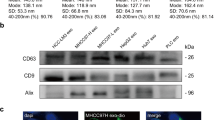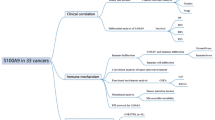Abstract
The EF-hand protein, S100A4, binds calcium ions and interacts specifically in vitro with protein targets. Elevated levels of S100A4 have been shown to produce a metastatic phenotype in independent models of breast cancer. The presence of S100A4 in the carcinoma cells of patients with different carcinomas is associated with reduced patient survival. In order to identify the region of the S100A4 molecule that is responsible for its metastasis-inducing properties, specific mutant S100A4 genes and proteins have been produced which contain targeted mutations to the two calcium-binding sites and a deletion of the last 15 amino-acid residues of the protein. The ability of the mutant proteins to bind to a potential specific target in vitro, nonmuscle myosin heavy chain, is correlated with their ability to cause motile, invasive and metastatic phenotypes. Mutation of the C-EF hand of S100A4 virtually abolished calcium binding and motility/invasion in vitro, abolished interaction with a molecular target and reduced metastasis induction by 2.5–3-fold. However, deletion of the last 15 amino acids of S100A4 reduced motility/invasion, target binding and metastasis-induction to similar extents as the C-EF-hand mutant, but reduced calcium binding by only 26%. The results suggest that the ability to interact with protein target(s) is important in S100A4-induced metastasis.
This is a preview of subscription content, access via your institution
Access options
Subscribe to this journal
Receive 50 print issues and online access
$259.00 per year
only $5.18 per issue
Buy this article
- Purchase on SpringerLink
- Instant access to full article PDF
Prices may be subject to local taxes which are calculated during checkout









Similar content being viewed by others
References
Ambartsumian N, Grigorian M, Larsen F, Karlstrom O, Sidenius N, Rygaard J, Georgiev G and Lukanidin E . (1996). Oncogene, 13, 1621–1630.
Ambartsumian N, Klingelhofer J, Grigorian M, Karlstrom O, Sidenius N, Georgiev G and Lukanidin E . (1999). Invas. Metast., 18, 96–104.
Anandappa S, Winstanley JHR, Leinster S, Green B, Rudland PS and Barraclough R . (1994). Br. J. Cancer, 69, 772–776.
Barraclough R, Gibbs FEM, Smith JA, Haynes GA and Rudland PS . (1990). Biochem. Biophys. Res. Commun., 169, 660–666.
Chen H-L, Fernig DG, Rudland PS, Sparks A, Wilkinson MC and Barraclough R . (2001). Biochem. Biophys. Res. Commun., 286, 1212–1217.
Chen H-L, Fernig DG, Rudland PS, Sparks A, Wilkinson MC and Barraclough R . (2003). Biochem. Biophys. Res. Commun., 308, 408.
Chirgwin JM, Przybyla AE, Macdonald RJ and Rutter WJ . (1979). Biochemistry, 18, 5294–5299.
Davies BR, Davies MPA, Gibbs FEM, Barraclough R and Rudland PS . (1993). Oncogene, 8, 999–1008.
Davies BR, O'Donnell M, Durkan GC, Rudland PS, Barraclough R, Neal DE and Mellon JK . (2002). J Pathol., 196, 292–299.
Davies MPA, Rudland PS, Robertson L, Parry EW, Jolicoeur PS and Barraclough R . (1996). Oncogene, 13, 1631–1637.
Donato R . (1999). Biochim. Biophys. Acta, 1450, 191–231.
Dower WJ, Miller JF and Ragsdale CW . (1988). Nucleic Acids Res., 16, 6127–6145.
Dunnington DJ, Monaghan P, Hughes CM and Rudland PS . (1983). J. Natl. Cancer Inst., 71, 1227–1240.
Ford H, Silver D, Cachar B, Sellers J and Zain S . (1997). Biochemistry, 36, 16321–16327.
Ford H and Zain S . (1995). Oncogene, 10, 1597–1605.
Gibbs FEM, Wilkinson MC, Rudland PS and Barraclough R . (1994). J. Biol. Chem., 269, 18992–18999.
Gongoll S, Peters G, Mengel M, Piso P, Klempnauer J, Kreipe H and von Wasielewski R . (2002). Gastroenterology, 123, 1478–1484.
Grigorian M, Andresen S, Tulchinsky E, Kriajevska M, Carlberg C, Kruse C, Cohn M, Ambartsumian N, Christensen A, Selivanova G and Lukanidin E . (2001). J. Biol. Chem., 276, 22699–22708.
Ho S, Hunt H, Horton R, Pullen J and Pease L . (1989). Gene, 77, 51–59.
Jenkinson SR, Barraclough R, West CR and Rudland PS . (2004). Br. J. Cancer, 90, 253–262.
Ke Y, Jing C, Barraclough R, Smith P, Davies MPA and Foster CS . (1997). Int. J. Cancer, 71, 832–837.
Kim EJ and Helfman DM . (2003). J. Biol. Chem., 278, 30063–30073.
Kimura K, Endo Y, Yonemura Y, Heizmann C, Schäfer B, Watanabe Y and Sasaki T . (2000). Int. J. Oncology, 16, 1125–1131.
Kligman D and Hilt DC . (1988). TIBS., 13, 437–443.
Kriajevska M, Cardenas M, Grigorian M, Ambartsumian N, Georgiev G and Lukanidin E . (1994). J. Biol. Chem., 269, 19679–19682.
Kriajevska M, Fischer-Larsen M, Moertz E, Vorm O, Tulchinsky E, Grigorian M, Ambartsumian N and Lukanidin E . (2002). J. Biol. Chem., 277, 5229–5235.
Lloyd B, Platt-Higgins A, Rudland P and Barraclough R . (1998). Oncogene, 17, 465–473.
Nakamura T, Ajiki T, Murao S, Kamigaki T, Maeda S, Ku Y and Kuroda Y . (2002). Int. J. Oncol., 20, 937–941.
Ninomiya I, Ohta T, Fushida S, Endo Y, Hashimoto T, Yagi M, Fujimura T, Nishimura G, Tani T, Shimizu K, Yonemura Y, Heizmann CW, Schäfer BW, Sasaki T and Miwa K . (2001). Int. J. Oncol., 18, 715–720.
Rahmoune H, Chen HL, Gallagher JT, Rudland PS and Fernig DG . (1998). J. Biol. Chem., 273, 7303–7310.
Rudland PS, Platt-Higgins A, Renshaw C, West CR, Winstanley JHR, Robertson L and Barraclough R . (2000). Cancer Res., 60, 1595–1603.
Sambrook J, Fritsch EF and Maniatis T . (1989). Molecular Cloning: A Laboratory Manual, 2nd edn. Cold Spring Harbor Laboratory Press: Cold Spring Harbor, NY.
Schäfer B . (1996). Guidebook to the Calcium-binding Proteins Celio M (ed). Oxford University Press: Oxford, pp 132–134.
Schagger H and Von Jagow G . (1987). Anal. Biochem., 166, 368–379.
Schauder BM, Blocker H, Frank R and McCarthy JEG . (1987). Gene, 52, 279–283.
Takenaga K, Nakamura Y, Sakiyama S, Hasegawa Y, Sato K and Endo H . (1994). J. Cell Biol., 124, 757–768.
Tarabykina S, Kriajevska M, Scott DJ, Hill TJ, Lafitte D, Derrick PJ, Dodson GG, Lukanidin E and Bronstein I . (2000). FEBS Lett., 475, 187–191.
Tarabykina S, Scott DJ, Herzyk P, Hill TJ, Tame JR, Kriajevska M, Lafitte D, Derrick PJ, Dodson GG, Maitland NJ, Lukanidin EM and Bronstein IB . (2001). J. Biol. Chem., 276, 24212–24222.
Vallely KM, Rustandi RR, Ellis KC, Varlamova O, Bresnick AR and Weber DJ . (2002). Biochemistry, 41, 12670–12680.
Wang G, Rudland PS, White MRH and Barraclough R . (2000). J. Biol. Chem., 275, 11141–11146.
Watanabe Y, Usada N, Minami H, Morita T, Tsugane S-i, Ishikawa R, Kohama K, Tomida Y and Hidaka H . (1993). FEBS Lett., 324, 51–55.
Zhang S, Wang G, Fernig DG, Rudland PS, Webb S, Barraclough R and Martin-Fernandez M . (2005). Eur. Biophys. J., 34, 19–27.
Acknowledgements
We thank Mrs Angela Platt Higgins for help with histology and Mr Joe Carroll for technical assistance with animals. The work could not have been carried out without the financial support from the Breast Cancer Campaign, the North West Cancer Research Fund and the Cancer and Polio Research Fund Ltd.
Author information
Authors and Affiliations
Rights and permissions
About this article
Cite this article
Zhang, S., Wang, G., Liu, D. et al. The C-terminal region of S100A4 is important for its metastasis-inducing properties. Oncogene 24, 4401–4411 (2005). https://doi.org/10.1038/sj.onc.1208663
Received:
Revised:
Accepted:
Published:
Issue date:
DOI: https://doi.org/10.1038/sj.onc.1208663
Keywords
This article is cited by
-
Joining S100 proteins and migration: for better or for worse, in sickness and in health
Cellular and Molecular Life Sciences (2014)



